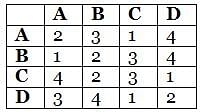Class 5 Exam > Class 5 Tests > Olympiad Test : Ecosystem - 1 - Class 5 MCQ
Olympiad Test : Ecosystem - 1 - Class 5 MCQ
Test Description
10 Questions MCQ Test - Olympiad Test : Ecosystem - 1
Olympiad Test : Ecosystem - 1 for Class 5 2024 is part of Class 5 preparation. The Olympiad Test : Ecosystem - 1 questions and answers have been prepared
according to the Class 5 exam syllabus.The Olympiad Test : Ecosystem - 1 MCQs are made for Class 5 2024 Exam.
Find important definitions, questions, notes, meanings, examples, exercises, MCQs and online tests for Olympiad Test : Ecosystem - 1 below.
Solutions of Olympiad Test : Ecosystem - 1 questions in English are available as part of our course for Class 5 & Olympiad Test : Ecosystem - 1 solutions in
Hindi for Class 5 course.
Download more important topics, notes, lectures and mock test series for Class 5 Exam by signing up for free. Attempt Olympiad Test : Ecosystem - 1 | 10 questions in 20 minutes | Mock test for Class 5 preparation | Free important questions MCQ to study for Class 5 Exam | Download free PDF with solutions
Olympiad Test : Ecosystem - 1 - Question 1
What are those plants and animals called that get their energy by eating other things?
Detailed Solution for Olympiad Test : Ecosystem - 1 - Question 1
Detailed Solution for Olympiad Test : Ecosystem - 1 - Question 2
| 1 Crore+ students have signed up on EduRev. Have you? Download the App |
Detailed Solution for Olympiad Test : Ecosystem - 1 - Question 3
Detailed Solution for Olympiad Test : Ecosystem - 1 - Question 4
Olympiad Test : Ecosystem - 1 - Question 5
Savanna and Prairies are the types of ______ ecosystems.
Detailed Solution for Olympiad Test : Ecosystem - 1 - Question 5
Olympiad Test : Ecosystem - 1 - Question 6
Nutrients present in plants and animals are used again and again with the help of:
Detailed Solution for Olympiad Test : Ecosystem - 1 - Question 6
Olympiad Test : Ecosystem - 1 - Question 7
Study the following chain. Who among the following can be termed as consumers?
Plants → Rabbit → Snake → Eagle
Detailed Solution for Olympiad Test : Ecosystem - 1 - Question 7
Detailed Solution for Olympiad Test : Ecosystem - 1 - Question 8
Detailed Solution for Olympiad Test : Ecosystem - 1 - Question 9
Olympiad Test : Ecosystem - 1 - Question 10
Which of the following sets represents primary consumers?
Detailed Solution for Olympiad Test : Ecosystem - 1 - Question 10
Information about Olympiad Test : Ecosystem - 1 Page
In this test you can find the Exam questions for Olympiad Test : Ecosystem - 1 solved & explained in the simplest way possible.
Besides giving Questions and answers for Olympiad Test : Ecosystem - 1, EduRev gives you an ample number of Online tests for practice
Download as PDF



















